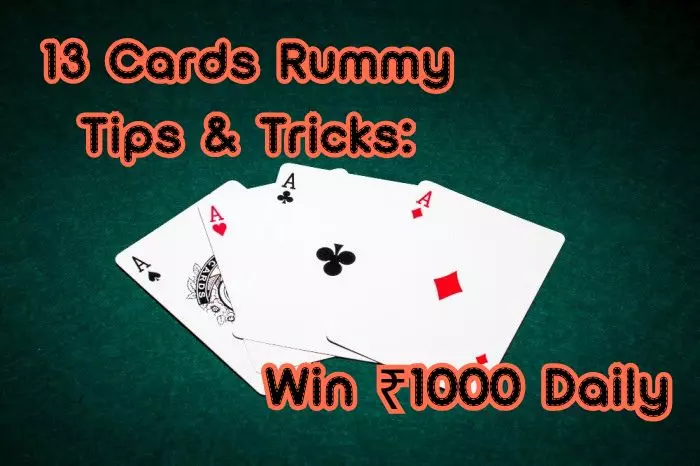
13 Cards Rummy Tips & Tricks: Win ₹1000 Daily
Winning at online Rummy isn’t just about luck—it’s about playing smart. Whether you play for fun or for real money, mastering a few clever strategies can transform your game. Here are seven time-tested Rummy tricks that’ll help you level up your skills and even bag up to ₹1000 daily if you play consistently and wisely.
Let’s dive right into it, shall we?
1. Formulate a Game Plan Early
Before you play your first card, take a moment to strategise. Will you go for pure sequences straight away? Or are you playing defensively by watching your opponents and blocking their moves?
Without a plan, you risk holding on to deadwood or discarding something crucial later on. But remember: if your strategy isn’t working, adapt fast—because Rummy is a game of shifts.
2. Be Ready to Adapt Mid-Game
A good Rummy player is flexible. Your initial hand may look promising for a sequence, but if the cards don’t fall into place, don’t wait endlessly for the perfect draw.
If it’s not working, change your plan. A stubborn Rummy player is often a losing one.
3. Watch What Your Opponent Picks & Drops
This is where psychology meets skill. Keep an eye on the discard pile and observe what your opponents are picking up or throwing away. Are they collecting hearts? Then don’t discard that 8♥ they’re probably eyeing.
It may seem minor, but this awareness can completely shift the game in your favour.
4. Discard Cards Your Opponent Doesn’t Need
This is one of the smartest defensive tricks. If your opponent is dumping clubs, follow suit—literally. Avoid feeding them cards they can use. And if you can afford it, hold back cards they might need, especially before their first meld.
This tactic slows down their progress and puts you in control.
5. Drop High-Value Cards Early (Unless They're Useful)
Picture this: your opponent declares and you're stuck holding a King, Queen, and Ace. Ouch. That’s a lot of penalty points.
If your high cards don’t fit into a potential sequence or set soon, drop them. Don’t wait for miracles—waiting too long might cost you the match.
Pro Tip: If you're holding a near-sequence like 9-10-Q-K, but missing a J, calculate the risk of keeping them. If you're close to finishing, go for it. If not, let 'em go.
6. Pick from the Discard Pile Selectively
Every time you take from the discard pile, you reveal something about your hand. That 6♦ you grabbed? Now your opponent knows you're building a run in diamonds.
Only pick from the discard pile when it truly helps you. Otherwise, draw from the stock pile and stay under the radar.
7. Be Alert When Opponents Are Nearing Finish
If someone has only a few cards left and you’ve not even melded yet—it’s time to shift gears. Either rush to declare or start damage control by dropping high-point cards.
Remember: it's not always about winning. Sometimes it's about losing smart.
8. What to Discard First: 3, 6, 9, Q? Drop the Queen Before the Six
If you’re holding 3, 6, 9, and Q, you might wonder: Which card should I discard first?
The smart move is to discard the Queen (Q) first, then the 6. Here's why:
The Queen carries a higher penalty (10 points), and if it's not forming a set or sequence, it becomes dead weight. Always try to drop high-value cards early when they aren’t useful.
The Queen can only potentially connect upwards with a King (K), which is a limited and hard-to-build sequence.
On the other hand, 6 is much more flexible in forming valid runs:
It can combine with 4, 5, 7, and 8.
4 and 5 can connect downward with 3;
7 and 8 can link upward with 9.
So even though 6 isn’t a "power card," it gives you multiple combination paths, unlike the Queen.
👉 Best practice: Discard the Queen first, then evaluate if you can build a run using 3-6-9 or other combinations. It’s a safer way to retain potential sequences while reducing penalty points.
9. Tricking Your Opponent (a.k.a. Fishing Strategy)
In Rummy, smart players often bait their opponents into helping them complete valuable combinations—this tactic is called "Fishing". For example, if you’re aiming to complete a set of 10s and currently hold 10♠, 10♥, and 9♣, you can cleverly discard 9♣. Your opponent might see this and assume 10♣ is a safe discard—exactly what you need to complete your set.
By discarding cards that mislead your opponent about your true intention, you increase the chances of drawing key cards indirectly. Fishing works best when you track what your opponent picks up or drops and play a step ahead.
Final Thoughts
These Rummy tips and tricks aren’t just theory—they’re used by real players daily to win games (and real cash). Whether you're chilling after work or grinding tournaments, keeping these seven strategies in mind can truly transform your gameplay.
And who knows? With enough practice, ₹1000 a day might be just the beginning.